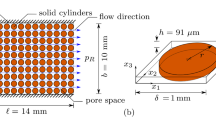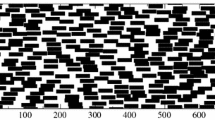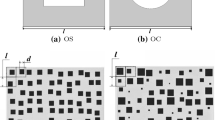Abstract
In this work, the tortuosity and the permeability of a porous medium whose geometry is idealized according to two Euclidean spatial dimensions is studied. Unit porous media solid matrices are taken as iterations toward the 2D Sierpinski carpet fractal geometry. Investigated porous media unit arrangements are either fully periodic (FP), or that of a periodic channel (PC), in which unit porous media geometries are infinitely stacked on both orthogonal directions or only in the flow direction inside a walled channel, respectively. A third case called adjusted fully periodic was also proposed as a counterpoint to the formation of the single preferential flow path of the FP case. The flow regime of interest is the Stokes (or creeping) one, and the numerical approach is done using the lattice Boltzmann method on a porous medium unit domain with a preset pressure drop. Moreover, the scale analysis technique is applied to obtain theoretical correlations for the permeability as a function of porous medium properties for the three cases. Good agreement is found between the correlations obtained herein with results available in the literature. A finding is that whenever the channel walls are removed, the PC case correlation recovers the one for FP. Finally, the results suggest a limit value for the iteration of the carpet beyond which the tortuosity and the permeability of the porous channel and the infinitely periodic (unwalled) porous media are equal.









Similar content being viewed by others
References
Adler, P.: Transport processes in fractals. vi. stokesow through sierpinski carpets. Phys. Fluids 29(1), 15–22 (1986)
Adler, P.: Fractal porous media iii: Transversal stokes flow through random and sierpinski carpets. Transp. Porous Med. 3(2), 185–198 (1988)
Amine, A., Platten, J., Hasnaoui, M.: Thermal convection around obstacles: the case of sierpinski carpets. Exp. Fluids 36(5), 717–727 (2004)
Bear, J., Verruijt, A.: Modeling groundwater flow and pollution, vol. 2. Springer, Berlin (2012)
Bejan, A.: The method of scale analysis: natural convection in porous media. Nat. Convec.: Fundam. Appl. 551, 548–572 (1985)
Bhatnagar, P .L., Gross, E .P., Krook, M.: A model for collision processes in gases. I. Small amplitude processes in charged and neutral one-component systems. Phys. Rev. 94, 511–525 (1954)
Botkin, D.B., Keller, E.A., et al.: Environmental science: earth as a living planet, 2nd edn. Wiley, New Jersey (1998)
Brinkman, H.: A calculation of the viscous force exerted by a flowing fluid on a dense swarm of particles. Flow Turbul. Combust. 1(1), 27 (1949)
Carman, P.C.: Fluid flow through granular beds. Trans. Inst. Chem. Eng. 15, 150–166 (1937)
Chen, Y., Li, Y., Valocchi, A.J., Christensen, K.T.: Lattice boltzmann simulations of liquid co2 displacing water in a 2d heterogeneous micromodel at reservoir pressure conditions. J. Contamin. Hydrol. (2017)
Clague, D., Kandhai, B., Zhang, R., Sloot, P.M.: Hydraulic permeability of (un) bounded fibrous media using the lattice boltzmann method. Phys. Rev. E 61(1), 616 (2000)
Cousins, T.A., Ghanbarian, B., Daigle, H.: Three-dimensional lattice boltzmann simulations of single-phase permeability in random fractal porous media with rough pore-solid interface. Transp. Porous Med. 122(3), 527–546 (2018)
Dietrich, P., Helmig, R., Sauter, M., Hötzel, H., Köngeter, J., Teutsch, G.: Flow and Transport in Fractured Porous Media, 1st edn. Springer, Berlin Heildelberg (2005)
Dullien, F.A.L.: Porous Media, 2nd edn. Academic Press, San Diego (1992)
Erol, S., Fowler, S.J., Harcouët-Menou, V., Laenen, B.: An analytical model of porosity-permeability for porous and fractured media. Transp. Porous Med. 120(2), 327–358 (2017)
Fu, J., Yu, Y.: Experimental study on pore characteristics and fractal dimension calculation of pore structure of aerated concrete block. Adv. Civ. Eng. 2019, (2019)
Ghilardi, P., Kai, A.K., Menduni, G.: Self-similar heterogeneity in granular porous media at the representative elementary volume scale. Water Resour. Res. 29(4), 1205–1214 (1993)
Guo, Z., Shu, C.: Lattice Boltzmann method and its applications in engineering, vol. 3. World Scientific, Singapore (2013)
Huai, X., Wang, W., Li, Z.: Analysis of the effective thermal conductivity of fractal porous media. Appl. Therm. Eng. 27(17–18), 2815–2821 (2007)
Inamuro, T., Ogata, T., Tajima, S., Konishi, N.: A lattice boltzmann method for incompressible two-phase flows with large density differences. J. Comput. Phys. 198(2), 628–644 (2004)
Jin, H.-Q., Yao, X.-L., Fan, L.-W., Xu, X., Yu, Z.-T.: Experimental determination and fractal modeling of the effective thermal conductivity of autoclaved aerated concrete: Effects of moisture content. Int. J. Heat Mass Transf. 92, 589–602 (2016)
Jin, Y., Zhu, Y., Li, X., Zheng, J., Dong, J.: Scaling invariant effects on the permeability of fractal porous media. Transp. Porous Med. 109(2), 433–453 (2015)
Khabbazi, A.E., Hinebaugh, J., Bazylak, A.: Analytical tortuosity-porosity correlations for sierpinski carpet fractal geometries. Chaos Solitons Fract. 78, 124–133 (2015)
Kozeny, J.: Über kapillare leitung des wassers im boden:(aufstieg, versickerung und anwendung auf die bewässerung). Hölder-Pichler-Tempsky (1927)
Lage, J.: The fundamental theory of flow through permeable media from darcy to turbulence. Transp. Phenomena Porous Med. 1, 1 (1998)
Latt, J.: Choice of units in lattice boltzmann simulation (2008). Wiki.palabos.org/_media/howtos:lbunits.pdf
Latt, J., Chopard, B.: Lattice boltzmann method with regularized pre-collision distribution functions. Math. Comput. Simul. 72(2–6), 165–168 (2006)
Li, C., Lin, M., Ji, L., Jiang, W.: Multiphase flow in tight sandstone: An improved application for 3d intermingled fractal model. J. Petrol. Sci. Eng. 177, 403–414 (2019)
Li, C., Xu, P., Qiu, S., Zhou, Y.: The gas effective permeability of porous media with Klinkenberg effect. J. Nat. Gas Sci. Eng. 34, 534–540 (2016)
Li, J.-H., Yu, B.-M.: Tortuosity of flow paths through a sierpinski carpet. Chin. Phys. Lett. 28(3), 034701 (2011)
Lü, Q., Qiu, Q., Zheng, J., Wang, J., Zeng, Q.: Fractal dimension of concrete incorporating silica fume and its correlations to pore structure, strength and permeability. Constr. Build. Mater. 228, 116986 (2019)
Luo, L., Yu, B., Cai, J., Zeng, X.: Numerical simulation of tortuosity for fluid flow in two-dimensional pore fractal models of porous media. Fractals 22(04), 1450015 (2014)
Mandelbrot, B. B.: Les objets fractals: forme, hasard et dimension (1975)
Mandelbrot, B.: The Fractal Geometry of Nature. Henry Holt and Company, New York (1982)
Martys, N.S., Hagedorn, J.G.: Multiscale modeling of fluid transport in heterogeneous materials using discrete boltzmann methods. Mater. Struct. 35(10), 650–658 (2002)
Matyka, M., Koza, Z.: How to calculate tortuosity easily? AIP Conf. Proc. 1453(1), 17–22 (2012)
Meira, R.E.C.P., De Lai, F.C., Negrão, C.O.R., Junqueira, S.L.M.: On determining the power law fluid friction factor in a partially porous channel using the lattice boltzmann method). Phys. Fluids 32, 1 (2020)
Mohamad, A.A.: Lattice Boltzmann Method: Fundamentals and Engineering Applications with Computer Codes, 1st edn. Springer, London (2011)
Montazerian, H., Zhianmanesh, M., Davoodi, E., Milani, A., Hoorfar, M.: Longitudinal and radial permeability analysis of additively manufactured porous scaffolds: Effect of pore shape and porosity. Mater. Des. 122, 146–156 (2017)
Nield, D.A., Bejan, A., et al.: Convection in Porous Media, vol. 3. Springer, Berlin (2006)
Niya, S.R., Selvadurai, A.: A statistical correlation between permeability, porosity, tortuosity and conductance. Transp. Porous Med. 121(3), 741–752 (2018)
Pan, C., Hilpert, M., Miller, C.: Lattice-boltzmann simulation of two-phase flow in porous media. Water Resour. Res. 40(1), 1 (2004)
Philippi, P.C., Hegele Jr., L.A., Dos Santos, L.O., Surmas, R.: From the continuous to the lattice boltzmann equation: the discretization problem and thermal models. Phys. Rev. E 73(5), 056702 (2006)
Reis, F.A., Bolster, D., Voller, V.R.: Anomalous behaviors during infiltration into heterogeneous porous media. Adv. Water Resour. 113, 180–188 (2018)
Rosenzweig, R., Shavit, U.: The laminar flow field at the interface of a sierpinski carpet configuration. Water Resour Res 43(10), 1 (2007)
Rostamzadeh, H., Salimi, M., Taeibi-Rahni, M.: Permeability correlation with porosity and knudsen number for rarefied gas flow in Sierpinski carpets. J. Nat. Gas Sci. Eng. 56, 549–567 (2018)
Sahimi, M.: Flows in Porous Media and Fractured Rock: From Classical Models to Modern Approaches, 1st edn. Wiley, Michigan (1995)
Saleh, S., Thovert, J., Adler, P.: Flow along porous media by partical image velocimetry. AIChE J. 39(11), 1765–1776 (1993)
Shen, X., Li, L., Cui, W., Feng, Y.: Improvement of fractal model for porosity and permeability in porous materials. Int. J. Heat Mass Transf. 121, 1307–1315 (2018)
Sobera, M., Kleijn, C.: Hydraulic permeability of ordered and disordered single-layer arrays of cylinders. Phys. Rev. E 74(3), 036301 (2006)
Somerton, C.W., Wood, P.: Effect of walls in modeling flow through porous media. J. Hydraul. Eng. 114(12), 1431–1448 (1988)
Song, W., Wang, D., Yao, J., Li, Y., Sun, H., Yang, Y., Zhang, L.: Multiscale image-based fractal characteristic of shale pore structure with implication to accurate prediction of gas permeability. Fuel 241, 522–532 (2019)
Succi, S., Foti, E., Higuera, F.: Three-dimensional flows in complex geometries with the lattice Boltzmann method. EPL (Europhys. Lett.) 10(5), 433 (1989)
Tamayol, A., Bahrami, M.: Analytical determination of viscous permeability of fibrous porous media. Int. J. Heat Mass Transf. 52(9–10), 2407–2414 (2009)
Tamayol, A., Bahrami, M.: Transverse permeability of fibrous porous media. Phys. Rev. E 83(4), 046314 (2011)
Tamayol, A., Khosla, A., Gray, B., Bahrami, M.: Creeping flow through ordered arrays of micro-cylinders embedded in a rectangular minichannel. Int. J. Heat Mass Transf. 55(15–16), 3900–3908 (2012)
Wang, B., Jin, Y., Chen, Q., Zheng, J., Zhu, Y., Zhang, X.: Derivation of permeability-pore relationship for fractal porous reservoirs using series-parallel flow resistance model and lattice boltzmann method. Fractals 22(03), 1440005 (2014)
Wei, W., Cai, J., Hu, X., Fan, P., Han, Q., Lu, J., Cheng, C.-L., Zhou, F.: A numerical study on fractal dimensions of current streamlines in two-dimensional and three-dimensional pore fractal models of porous media. Fractals 23(01), 1540012 (2015)
Yu, B., Li, J.: Some fractal characters of porous media. Fractals 9(03), 365–372 (2001)
Zheng, J., Zhang, W., Zhang, G., Yu, Y., Wang, S.: Effect of porous structure on rarefied gas flow in porous medium constructed by fractal geometry. J. Nat. Gas Sci. Eng. 34, 1446–1452 (2016)
Zhou, A., Fan, Y., Cheng, W.-C., Zhang, J.: A fractal model to interpret porosity-dependent hydraulic properties for unsaturated soils. Adv. Civ. Eng. 2019, 1 (2019)
Zhou, H., Zhong, J., Ren, W., Wang, X., Yi, H.: Characterization of pore-fracture networks and their evolution at various measurement scales in coal samples using x-ray \(\mu\)ct and a fractal method. Int. J. Coal Geol. 189, 35–49 (2018)
Zou, Q., He, X.: On pressure and velocity. Phys. Fluids 9, 1591–1598 (1997)
Acknowledgements
This study was financed in part by the Coordenação de Aperfeiçoamento de Pessoal de Nível Superior—Brasil (CAPES)—Finance Code 001.
Author information
Authors and Affiliations
Corresponding author
Additional information
Publisher's Note
Springer Nature remains neutral with regard to jurisdictional claims in published maps and institutional affiliations.
Appendix 1: Grid Test Methodology
Appendix 1: Grid Test Methodology
The test seeks to minimize the total error represented by \(E_{total}=E_{\mathrm {Ma}}+E_{\varDelta {\varvec{x}}}+E_{\varDelta t}\), where \(E_{\mathrm {Ma}}\) represents the error associated with compressibility, \(\mathrm {Ma}\) is the Mach number, defined as by \(\mathrm {Ma}=|{\varvec{u}}|/c_{s}\), \(E_{\varDelta t}\) is the temporal error for a given time step and \(E_{\varDelta {\varvec{x}}}\) is the spatial error associated with the mesh. A similar grid test methodology was also employed by Meira et al. (2020) to study the flow of a power-law fluid in a channel partially filled by microscopic porous media.
The error related to compressibility is in the scale \(E_{\mathrm {Ma}}\sim {\mathrm {Ma}}^{2}\), for \(\mathrm {Ma}<1\). From that, the relationship between the errors is given by:
where \(E_{\varDelta {\varvec{x}}} \sim \varDelta {\varvec{x}}^{2}\), \(E_{\varDelta t} \sim \varDelta t^{2}\). The ratio \(r=\varDelta {\varvec{x}}/\varDelta t\) is the lattice spacing divided by the time increment, both defined according to Latt (2008).
To minimize \(E_{\mathrm {Ma}}\) and \(E_{\varDelta t}\) for an acceptable tolerance, the test consists of keeping the spatial grid size \(\varDelta {\varvec{x}}\) fixed and gradually decreasing the time step \(\varDelta t\) by increasing the parameter r. This procedure eliminates the temporal errors, leaving the total error \(E_{total}\) dominated by \(E_{\varDelta {\varvec{x}}}\) only, i.e., \(E_{total}\approx E_ {\varDelta {\varvec{x}}}\). In the permeability results of Tables 4 and 5, respectively, for the FP and PC cases, the tolerance was set to \(\varDelta t=2\%\).
In the sequence, one refines \(\varDelta {\varvec{x}}\) by gradually doubling the number of mesh nodes. Then, as r increases in the same proportion, the quadratic decrease of \(\varDelta t\) regarding to \(\varDelta {\varvec{x}}\) guarantees that \(E_{total}\approx E_{\varDelta {\varvec{x}}}\). Accordingly, for a given tolerance, the successive refinement of \(\varDelta {\varvec{x}}\) ensures results independent of \(\varDelta {\varvec{x}}\) and \(\varDelta t\). For a tolerance of \(\varDelta {\varvec{x}}=3\%\) in the variation of the permeability results of the FP and PC arrangements, Table 6 shows the final part of the proposed grid test.
Rights and permissions
About this article
Cite this article
Bazarin, R.L.M., De Lai, F.C., Naaktgeboren, C. et al. Boundary Effects on the Tortuosity and Permeability of Idealized Porous Media. Transp Porous Med 136, 743–764 (2021). https://doi.org/10.1007/s11242-020-01530-w
Received:
Accepted:
Published:
Issue Date:
DOI: https://doi.org/10.1007/s11242-020-01530-w




